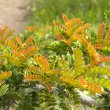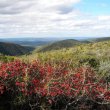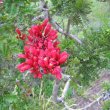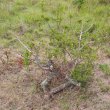| Botanical Name |
|
| Family |
Fabaceae - The legume and pod-bearing family. (Pea & Bean Family) |
| Pronunciation |
|
| Common Name(s) |
English: Karoo boer-bean; Small Boer Bean
Afrikaans: Karoo-boerboon; Kleinboerboontjie
IsiXhosa: umgxam; intiza; Umqongci
|
| Plant Group |
- Tree A woody, self-supporting perennial plant usually with a single main stem and generally growing more than 6 meters tall.
|
| Plant Size |
- Very Small
| Tree | 3m to 4m |
| Shrub | 25cm to 50cm |
| Perennial/ground cover | Up to 10cm |
| Bulb | 10cm to 20cm |
| Succulent | Up to 5cm |
|
| Position |
- Partial Shade The area is in shade for part of the day and in full sun for part of the day.
- Sun The area is in full sun for all or most of the day, all year round.
|
| General Information |
- Attractive fruits, berries or seeds Brightly coloured fruits or berries increase and extend the visual impact of the plant and are especially attractive to birds and other small wildlife.
- Drought Tolerance: High The plant is well adapted to arid conditions; it can survive long periods of drought and high temperatures without extra water.
- Evergreen Plants that have leaves all year round.
- Frost: Hardy The plant can withstand freezing temperatures or frost without artificial protection.
- Roots Non-invasive Safe to plant near pools, paving, walls or buildings.
- Water Wise Plant species originating from low rainfall regions that require less water to survive and thrive than other plant species.
- Wind Tolerant Plants able to withstand the effect of strong winds.
|
| Specific Information |
Schotia afra var. afra, with its attractive flowers, non-invasive root system, gnarled trunk and small stature, is highly suited to small gardens. The flowers produce an abundance of nectar which attracts birds and butterflies. After flowering, large, lime green to pinkish seed pods are produced which turn brown when ripe. This tree can tolerate some pruning to keep it in shape.
|
| Ad Break |
|
| Flowers |
| Description |
pea flowers in small clusters
|
| Season |
- Summer to Autumn Plants will seldom bloom for the entire season as given in the list, but should flower during a period within these parameters.
|
| Colour |
|
| Growth Rate |
- Moderate to Fast Specifying growth rate can be very misleading as there is considerable variation of growth rate depending on type and species of plant, available water, supplementary feeding, mulching and general care, as well as the plants suitability and adaptability to the garden environment.
|
| Plant Uses |
- Attracts bees, butterflies or other insects This plant attracts insects which can be food for birds or other creatures in your garden.
- Attracts Birds This plant will attract birds.
- Boundary A plant useful for planting around the edges of the property to form a green or colourful backdrop, an impenetrable hedge, to hide walls or create privacy.
- Filler Either a fast growing tree or shrub used temporarily to fill in an area while the permanent plants grow to a desired size, or a plant used to fill gaps in borders or beds.
- Rock Garden An area constructed of larger rocks, arranged naturally, to emphasise the use of stones as a main element. Generally plants used do not need a lot of care.
- Suitable for bonsai A shrub or tree that lends itself to being dwarfed.
- Suitable for coastal gardens Plants adapted to dry, sandy soil, forceful wind, limited rainfall and intense sunlight.
- Suitable for smaller gardens Such plants do not have invasive root systems, remain small or controllable and can often be grown in containers.
- Wild Garden An indigenous garden planted for the benefit of wildlife and birds. Provides food, water, a variety of mini-biomes and no poisonous chemicals are used.
|
| Distribution and Habitat |
the southern part of the Western Cape, the Eastern Cape and the Little Karoo, in scrub bush and along the banks of dry streams and rivers
|
| Planting Suggestions |
The Karoo boer-bean requires well-drained soil and regular watering until established. For fast growth water well once a week especially if conditions are dry. Stake the tree while young to prevent wind damage. Under ideal conditions this tree will be providing shade within five years.
The old method of digging a deep hole and filling it with soil and compost has resulted in many trees failing to thrive, dying, rotting at the base or worse still, falling over in later years due to poor root development. Refer to the following sites for the best method of planting trees:
Treehelp.com: Planting a tree
International Society of Arboriculture: New Tree Planting
Tree People: Plant the right way
For those of you who have a clay problem try:
Rod's Garden: Planting in clay soil
|
| Medicinal Uses |
The seeds are edible whether ripe or unripe. Early settlers and indigenous dwellers roasted and pounded seeds to use as kind of meal. The ground bark soaked in water can be used as tannin.
|
| Ad Break |
|










Comments
Boerboon
I discovered that if you scrape the dried seeds with a sharp object like a bread knife to imitate the way antelope or elephant teeth would scrape them they loose the tough membrane very quickly and it speeds up the germination of the seeds. While living in SA I grew numerous boerboon trees to repopulate goat grazed areas.
Scarifying hard-coated seeds
Hi David
You are quite right. This method is called scarifying aand is used with Boerboon, Diospyros, Erithryina, Apodytes and a number of other very hard-coated seeds. I usually rub them on a piece of medium grain sandpaper - I'm not safe with knives! Some of them can be soaked in warm water overnight and then just need a pin prick to penetrate the coat.
I really need to get back to my older posts and include this information on the relevant pages. Thanks for your comment.
Kind regards
Lorraine
transplant boer been tree in my garden
Is it possible to transplant my boer bean tree about 10 meters from where it is presently?
Transplanting trees
Hi Colleen
My sincere apologies for not having replied to your comment so very long ago.
If the tree is very young (1 - 3 years old), it may be successful. If it is older than that, you can try but it is quite likely that the tree will die. Google for information on transplanting mature trees.
Kind regards
Lorraine
Discuss this plant
Share knowledge, ask a question or give an experience.